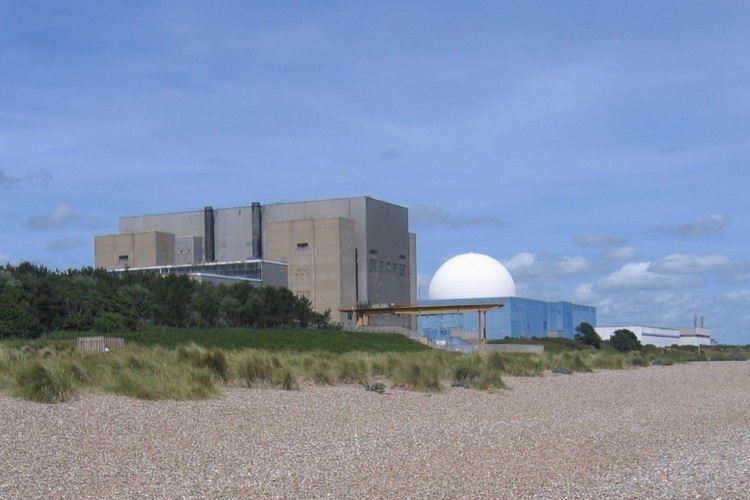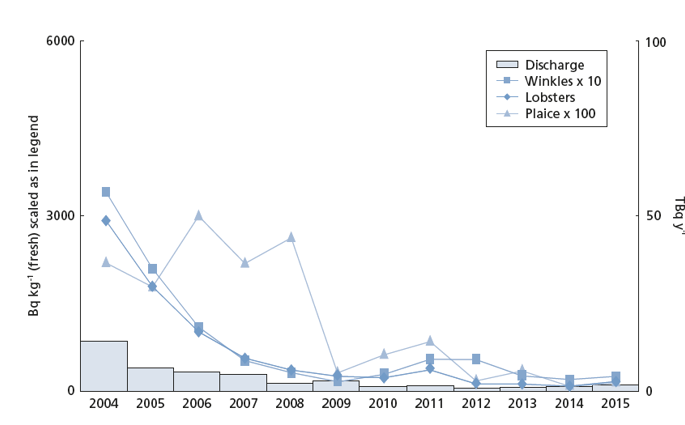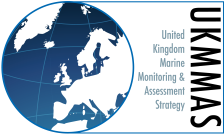Concentrations of radionuclides
Monitoring to determine radionuclide concentrations and to assess radiological risk to the marine environment has confirmed that doses received by people and wildlife continue to be well below the UK national and European regulatory limits and that the UK target has been achieved.
Background
UK target on radionuclides
This indicator is used to assess progress against the target set out in the Marine Strategy Part One (HM Government, 2012), which requires that concentrations of substances identified within relevant legislation and international obligations are below the concentrations at which adverse effects are likely to occur.
Key pressures and impacts
Radioactive materials have many applications from the generation of electricity (Figure 1) to diagnostic tools in medicine. As a result, small quantities of radioactivity may be released into the environment as discharges, emissions and losses from nuclear licensed sites and from non-nuclear facilities such as medical establishments. In addition, from the non-nuclear sector, small quantities of naturally occurring radioactive material may be released into the environment as discharges from the offshore oil and gas industry.

Figure 1. Sizewell Power Stations (Crown Copyright).
Measures taken to address the impacts
The main measures to protect people and wildlife is the regulation of radioactive waste under the Environmental Permitting (England and Wales) Regulations 2016 (HM Government, 2016) and under the Radioactive Substances Act 1993 (HM Government, 1993) in Scotland and Northern Ireland. Radioactive discharges are strictly controlled, discharge levels have generally reduced, and a strategy is in place to further reduce discharge levels in the future.
Monitoring, assessment and regional co-operation
Areas that have been assessed
Assessments were conducted at the scale of the UK-portion of the Greater North Sea and Celtic Seas Marine Strategy Framework Directive sub-regions, with emphasis on those seawaters receiving discharges from UK nuclear establishments (Figure 2). Furthermore, as a basis for the reporting and evaluation of concentrations of radioactive substances in the OSPAR maritime area, a monitoring agreement has been identified using 15 OSPAR monitoring areas and specifying the radionuclides and environmental compartments for which data are to be collected (Figure 3).

Figure 2. Licensed nuclear sites discharging radioactivity into the marine environment, Radioactivity in Food and the Environment (RIFE) report 21 (Cefas, 2015).

Figure 3. OSPAR monitoring areas identified for the establishment of baselines concentrations of radioactive substances.
Monitoring and assessment methods
Each year, marine environmental samples (including water, sediment and biota) are collected routinely from UK seas around the nuclear licensed sites (Figure 1), including from those locations required for the OSPAR purposes. The results of annual monitoring programmes are used to assess the radiological risk and to check whether doses are below the UK national and European regulatory limits of 1mSv per year for members of the public.
The types of sample species and radionuclides for monitoring are selected by the responsible UK environmental agencies on the basis of a risk-based review performed 2012 (Food Standards Agency, 2012) and previous radiological monitoring surveys. The environmental samples are collected according to annual schedules and analysed to the ISO 17025 standard of formally accredited methods.
Assessment threshold
The International Commission on Radiological Protection provides guidance on assessing radiological dose to the general public. These dose standards are embodied in UK national policy on radioactive waste. The radionuclide concentrations are compared with UK regulatory limits of dose.
Regional co-operation
The UK played a leading role in preparing the OSPAR Fourth Periodic Evaluation of Radioactive Substances (OSPAR Commission, 2016), which evaluates progress made on reducing discharges from the nuclear and non-nuclear sectors.
Assessment method
Methods details can be found in the Radioactivity in Food and the Environment report series reports.
Results
Findings from the 2012 UK Initial Assessment
Doses of radioactivity received by people and wildlife continue to be well within regulatory limits
Latest findings
Radiological monitoring and assessment are supported by observations of discharge and trend analyses of specific radionuclides and species at different locations, each with specific associated issues.
Status assessment
Radiological assessments confirm that doses received by people and wildlife continue to be well below the UK national and European regulatory limits.
Trend assessment
Concentrations of radionuclides in seafood (fish and shellfish) have generally shown a downward trend or have continued to decline.
Further information
Full results can be found in the most recent Radioactivity in Food and the Environment report. Selected key results are were:
- Environmental concentrations of Technetium-99 have decreased in fish and shellfish in response to declining discharges at Sellafield (Figure 4).

Figure 4. Technetium-99 liquid discharge from Sellafield and concentrations in plaice, lobsters and winkles near Sellafield, 2004 to 2015.
- Polonium-210 levels in seafood around Whitehaven have decreased and levels in crustacean are continuing to be within, or close to, the expected range of natural sources. The largest contribution to radioactivity dose to seafood consumers is from Polonium--210, but it remains well within regulatory limits.
- Radioactive discharges of Hydrogen-3 and Carbon-14 from Cardiff have continued to decline and since 2015 the site has ceased operations, resulting in a significant downward trend in radioactivity concentrations in seafood.
- Radium-226, Radium-228 and Lead-210 discharged from the offshore oil and gas industry fell by about 25% (between 2000 to 2006) and continue to reduce in line with declining production.
Radioactive fragments continue to be detected and removed from Sellafield and Dounreay beaches. Both beaches remain open and there is no risk to beach users. Part of the beach at Dalgety Bay is closed and, as a protection measure, shellfish harvesting has been banned. The overall health risks at Sellafield to beach users from fragments are very low. Monitoring programmes continue to locate and retrieve fragments from the foreshores. Environmental concentrations were predicted using models to assess the dose rates to reference organisms for authorised discharge. All but two of the habitat sites were less than an agreed threshold of 40μGy h-1, with habitat assessments indicating the environment has or could be adversely impacted.
Conclusions
Continuation of monitoring programmes, reported in the annual publication of Radioactivity in Food and the Environment series, confirm that radioactivity levels in UK waters currently pose no risk of harm to humans or wildlife.
Knowledge gaps
No knowledge gaps have been identified.
References
Cefas (2015) ‘Radioactivity in Food and the Environment Report, 2015’ RIFE-21 (viewed on 7 November 2018)
Food Standards Agency (2012) Radioactivity in Food Monitoring Review Food Standards Agency, London
HM Government (1993) ‘Radioactive Substances Act 1993’ Chapter 12 (viewed on 7 November 2018)
HM Government (2012) ‘Marine Strategy Part One: UK Initial Assessment and Good Environmental Status’ (viewed on 5 July 2018)
HM Government (2016) ‘The Environmental Permitting (England and Wales) Regulations 2016’ Statutory Instruments Number 1154 (viewed on 7 November 2018)
Acknowledgements
Assessment metadata
| Assessment Type | UK Marine Strategy Framework Directive Indicator Assessment |
|---|---|
UK_CSSEG_D8_contaminants
| |
Radionuclides | |
The International Commission on Radiological Protection (ICRP) provides guidance on assessing radiological dose to the general public. These dose standards are embodied in UK national policy on radioactive waste. The radionuclide concentrations are compared with UK regulatory limits of dose. | |
| Point of contact email | marinestrategy@defra.gov.uk |
| Metadata date | Saturday, October 1, 2016 |
| Title | Radionuclides |
| Resource abstract | This indicator is used to assess progress against the target set out in the Marine Strategy Part One which requires that concentrations of substances identified within relevant legislation and international obligations are below the concentrations at which adverse effects are likely to occur. Monitoring to determine radionuclide concentrations and to assess radiological risk to the marine environment has confirmed that doses received by people and wildlife continue to be well below the UK national and European regulatory limits and that the UK target has been achieved. |
| Linkage | In addition to links provided in ‘References’ section above: OSPAR Commission (2009) ‘Towards the Radioactive Substances Strategy objectives: Third Periodic Evaluation’ Publication Number 455 (viewed on 10 January 2019) OSPAR Commission (2016) ‘Fourth Periodic Evaluation of Progress Towards the Objective of the OSPAR Radioactive Substances Strategy’ Publication Number 687 (viewed on 10 January 2019) |
| Conditions applying to access and use | © Crown copyright, licenced under the Open Government Licence (OGL). The data, activity concentration data, habits information (consumption and occupancy rates) and dose coefficients, upon which the radiological assessments are determined are unrestricted. The methods of assessment are commercial in confidence to Cefas. |
| Assessment Lineage | Please, see details in the Radioactivity in Food and the Environment 2018 (RIFE) report https://assets.publishing.service.gov.uk/government/uploads/system/uploads/attachment_data/file/843281/Radioactivity_in_food_and_the_environment_2018_RIFE_24.pdf |
| Dataset metadata | Please see data sets in the appendix of the Radioactivity in Food and the Environment 2018 (RIFE) https://assets.publishing.service.gov.uk/government/uploads/system/uploads/attachment_data/file/841491/Radioactivity_in_food_and_the_environment_2018_appendix_1_CD_supplement.pdf |
| Dataset DOI | Marine Scotland. 2018. Contaminant and biological effect data to support MSFD Descriptor 8 1999-2015 by CSEMP Region. DOI: 10.7489/12111-1 |
The Metadata are “data about the content, quality, condition, and other characteristics of data” (FGDC Content Standard for Digital Geospatial Metadata Workbook, Ver 2.0, May 1, 2000).
Metadata definitions
Assessment Lineage - description of data sets and method used to obtain the results of the assessment
Dataset – The datasets included in the assessment should be accessible, and reflect the exact copies or versions of the data used in the assessment. This means that if extracts from existing data were modified, filtered, or otherwise altered, then the modified data should be separately accessible, and described by metadata (acknowledging the originators of the raw data).
Dataset metadata – information on the data sources and characteristics of data sets used in the assessment (MEDIN and INSPIRE compliance).
Digital Object Identifier (DOI) – a persistent identifier to provide a link to a dataset (or other resource) on digital networks. Please note that persistent identifiers can be created/minted, even if a dataset is not directly available online.
Indicator assessment metadata – data and information about the content, quality, condition, and other characteristics of an indicator assessment.
MEDIN discovery metadata - a list of standardized information that accompanies a marine dataset and allows other people to find out what the dataset contains, where it was collected and how they can get hold of it.
Recommended reference for this indicator assessment
Kins Leonard1 2018. Concentrations of radionuclides in the Celtic Sea and the Greater North Sea. UK Marine Online Assessment Tool, available at: https://moat.cefas.co.uk/pressures-from-human-activities/contaminants/radionuclides/
1Centre for Environment, Fisheries and Aquaculture Science
